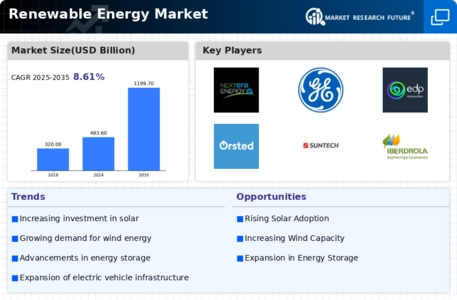Solar
Wind
Hydropower
Geothermal
Biomass
Photovoltaic
Concentrated Solar Power
Onshore Wind Turbines
Offshore Wind Turbines
Hydroelectric Power Plants
Electricity Generation
Heating
Transportation
Cooling
Industrial Processes
Residential
Commercial
Industrial
Utilities
North America
Europe
South America
Asia Pacific
Middle East and Africa
North America Outlook (USD Billion, 2019-2035)
North America Renewable Energy Market by Energy Source Type
Solar
Wind
Hydropower
Geothermal
Biomass
North America Renewable Energy Market by Technology Type
Photovoltaic
Concentrated Solar Power
Onshore Wind Turbines
Offshore Wind Turbines
Hydroelectric Power Plants
North America Renewable Energy Market by Application Type
Electricity Generation
Heating
Transportation
Cooling
Industrial Processes
North America Renewable Energy Market by End Use Type
Residential
Commercial
Industrial
Utilities
North America Renewable Energy Market by Regional Type
US
Canada
US Outlook (USD Billion, 2019-2035)
US Renewable Energy Market by Energy Source Type
Solar
Wind
Hydropower
Geothermal
Biomass
US Renewable Energy Market by Technology Type
Photovoltaic
Concentrated Solar Power
Onshore Wind Turbines
Offshore Wind Turbines
Hydroelectric Power Plants
US Renewable Energy Market by Application Type
Electricity Generation
Heating
Transportation
Cooling
Industrial Processes
US Renewable Energy Market by End Use Type
Residential
Commercial
Industrial
Utilities
CANADA Outlook (USD Billion, 2019-2035)
CANADA Renewable Energy Market by Energy Source Type
Solar
Wind
Hydropower
Geothermal
Biomass
CANADA Renewable Energy Market by Technology Type
Photovoltaic
Concentrated Solar Power
Onshore Wind Turbines
Offshore Wind Turbines
Hydroelectric Power Plants
CANADA Renewable Energy Market by Application Type
Electricity Generation
Heating
Transportation
Cooling
Industrial Processes
CANADA Renewable Energy Market by End Use Type
Residential
Commercial
Industrial
Utilities
Europe Outlook (USD Billion, 2019-2035)
Europe Renewable Energy Market by Energy Source Type
Solar
Wind
Hydropower
Geothermal
Biomass
Europe Renewable Energy Market by Technology Type
Photovoltaic
Concentrated Solar Power
Onshore Wind Turbines
Offshore Wind Turbines
Hydroelectric Power Plants
Europe Renewable Energy Market by Application Type
Electricity Generation
Heating
Transportation
Cooling
Industrial Processes
Europe Renewable Energy Market by End Use Type
Residential
Commercial
Industrial
Utilities
Europe Renewable Energy Market by Regional Type
Germany
UK
France
Russia
Italy
Spain
Rest of Europe
GERMANY Outlook (USD Billion, 2019-2035)
GERMANY Renewable Energy Market by Energy Source Type
Solar
Wind
Hydropower
Geothermal
Biomass
GERMANY Renewable Energy Market by Technology Type
Photovoltaic
Concentrated Solar Power
Onshore Wind Turbines
Offshore Wind Turbines
Hydroelectric Power Plants
GERMANY Renewable Energy Market by Application Type
Electricity Generation
Heating
Transportation
Cooling
Industrial Processes
GERMANY Renewable Energy Market by End Use Type
Residential
Commercial
Industrial
Utilities
UK Outlook (USD Billion, 2019-2035)
UK Renewable Energy Market by Energy Source Type
Solar
Wind
Hydropower
Geothermal
Biomass
UK Renewable Energy Market by Technology Type
Photovoltaic
Concentrated Solar Power
Onshore Wind Turbines
Offshore Wind Turbines
Hydroelectric Power Plants
UK Renewable Energy Market by Application Type
Electricity Generation
Heating
Transportation
Cooling
Industrial Processes
UK Renewable Energy Market by End Use Type
Residential
Commercial
Industrial
Utilities
FRANCE Outlook (USD Billion, 2019-2035)
FRANCE Renewable Energy Market by Energy Source Type
Solar
Wind
Hydropower
Geothermal
Biomass
FRANCE Renewable Energy Market by Technology Type
Photovoltaic
Concentrated Solar Power
Onshore Wind Turbines
Offshore Wind Turbines
Hydroelectric Power Plants
FRANCE Renewable Energy Market by Application Type
Electricity Generation
Heating
Transportation
Cooling
Industrial Processes
FRANCE Renewable Energy Market by End Use Type
Residential
Commercial
Industrial
Utilities
RUSSIA Outlook (USD Billion, 2019-2035)
RUSSIA Renewable Energy Market by Energy Source Type
Solar
Wind
Hydropower
Geothermal
Biomass
RUSSIA Renewable Energy Market by Technology Type
Photovoltaic
Concentrated Solar Power
Onshore Wind Turbines
Offshore Wind Turbines
Hydroelectric Power Plants
RUSSIA Renewable Energy Market by Application Type
Electricity Generation
Heating
Transportation
Cooling
Industrial Processes
RUSSIA Renewable Energy Market by End Use Type
Residential
Commercial
Industrial
Utilities
ITALY Outlook (USD Billion, 2019-2035)
ITALY Renewable Energy Market by Energy Source Type
Solar
Wind
Hydropower
Geothermal
Biomass
ITALY Renewable Energy Market by Technology Type
Photovoltaic
Concentrated Solar Power
Onshore Wind Turbines
Offshore Wind Turbines
Hydroelectric Power Plants
ITALY Renewable Energy Market by Application Type
Electricity Generation
Heating
Transportation
Cooling
Industrial Processes
ITALY Renewable Energy Market by End Use Type
Residential
Commercial
Industrial
Utilities
SPAIN Outlook (USD Billion, 2019-2035)
SPAIN Renewable Energy Market by Energy Source Type
Solar
Wind
Hydropower
Geothermal
Biomass
SPAIN Renewable Energy Market by Technology Type
Photovoltaic
Concentrated Solar Power
Onshore Wind Turbines
Offshore Wind Turbines
Hydroelectric Power Plants
SPAIN Renewable Energy Market by Application Type
Electricity Generation
Heating
Transportation
Cooling
Industrial Processes
SPAIN Renewable Energy Market by End Use Type
Residential
Commercial
Industrial
Utilities
REST OF EUROPE Outlook (USD Billion, 2019-2035)
REST OF EUROPE Renewable Energy Market by Energy Source Type
Solar
Wind
Hydropower
Geothermal
Biomass
REST OF EUROPE Renewable Energy Market by Technology Type
Photovoltaic
Concentrated Solar Power
Onshore Wind Turbines
Offshore Wind Turbines
Hydroelectric Power Plants
REST OF EUROPE Renewable Energy Market by Application Type
Electricity Generation
Heating
Transportation
Cooling
Industrial Processes
REST OF EUROPE Renewable Energy Market by End Use Type
Residential
Commercial
Industrial
Utilities
APAC Outlook (USD Billion, 2019-2035)
APAC Renewable Energy Market by Energy Source Type
Solar
Wind
Hydropower
Geothermal
Biomass
APAC Renewable Energy Market by Technology Type
Photovoltaic
Concentrated Solar Power
Onshore Wind Turbines
Offshore Wind Turbines
Hydroelectric Power Plants
APAC Renewable Energy Market by Application Type
Electricity Generation
Heating
Transportation
Cooling
Industrial Processes
APAC Renewable Energy Market by End Use Type
Residential
Commercial
Industrial
Utilities
APAC Renewable Energy Market by Regional Type
China
India
Japan
South Korea
Malaysia
Thailand
Indonesia
Rest of APAC
CHINA Outlook (USD Billion, 2019-2035)
CHINA Renewable Energy Market by Energy Source Type
Solar
Wind
Hydropower
Geothermal
Biomass
CHINA Renewable Energy Market by Technology Type
Photovoltaic
Concentrated Solar Power
Onshore Wind Turbines
Offshore Wind Turbines
Hydroelectric Power Plants
CHINA Renewable Energy Market by Application Type
Electricity Generation
Heating
Transportation
Cooling
Industrial Processes
CHINA Renewable Energy Market by End Use Type
Residential
Commercial
Industrial
Utilities
INDIA Outlook (USD Billion, 2019-2035)
INDIA Renewable Energy Market by Energy Source Type
Solar
Wind
Hydropower
Geothermal
Biomass
INDIA Renewable Energy Market by Technology Type
Photovoltaic
Concentrated Solar Power
Onshore Wind Turbines
Offshore Wind Turbines
Hydroelectric Power Plants
INDIA Renewable Energy Market by Application Type
Electricity Generation
Heating
Transportation
Cooling
Industrial Processes
INDIA Renewable Energy Market by End Use Type
Residential
Commercial
Industrial
Utilities
JAPAN Outlook (USD Billion, 2019-2035)
JAPAN Renewable Energy Market by Energy Source Type
Solar
Wind
Hydropower
Geothermal
Biomass
JAPAN Renewable Energy Market by Technology Type
Photovoltaic
Concentrated Solar Power
Onshore Wind Turbines
Offshore Wind Turbines
Hydroelectric Power Plants
JAPAN Renewable Energy Market by Application Type
Electricity Generation
Heating
Transportation
Cooling
Industrial Processes
JAPAN Renewable Energy Market by End Use Type
Residential
Commercial
Industrial
Utilities
SOUTH KOREA Outlook (USD Billion, 2019-2035)
SOUTH KOREA Renewable Energy Market by Energy Source Type
Solar
Wind
Hydropower
Geothermal
Biomass
SOUTH KOREA Renewable Energy Market by Technology Type
Photovoltaic
Concentrated Solar Power
Onshore Wind Turbines
Offshore Wind Turbines
Hydroelectric Power Plants
SOUTH KOREA Renewable Energy Market by Application Type
Electricity Generation
Heating
Transportation
Cooling
Industrial Processes
SOUTH KOREA Renewable Energy Market by End Use Type
Residential
Commercial
Industrial
Utilities
MALAYSIA Outlook (USD Billion, 2019-2035)
MALAYSIA Renewable Energy Market by Energy Source Type
Solar
Wind
Hydropower
Geothermal
Biomass
MALAYSIA Renewable Energy Market by Technology Type
Photovoltaic
Concentrated Solar Power
Onshore Wind Turbines
Offshore Wind Turbines
Hydroelectric Power Plants
MALAYSIA Renewable Energy Market by Application Type
Electricity Generation
Heating
Transportation
Cooling
Industrial Processes
MALAYSIA Renewable Energy Market by End Use Type
Residential
Commercial
Industrial
Utilities
THAILAND Outlook (USD Billion, 2019-2035)
THAILAND Renewable Energy Market by Energy Source Type
Solar
Wind
Hydropower
Geothermal
Biomass
THAILAND Renewable Energy Market by Technology Type
Photovoltaic
Concentrated Solar Power
Onshore Wind Turbines
Offshore Wind Turbines
Hydroelectric Power Plants
THAILAND Renewable Energy Market by Application Type
Electricity Generation
Heating
Transportation
Cooling
Industrial Processes
THAILAND Renewable Energy Market by End Use Type
Residential
Commercial
Industrial
Utilities
INDONESIA Outlook (USD Billion, 2019-2035)
INDONESIA Renewable Energy Market by Energy Source Type
Solar
Wind
Hydropower
Geothermal
Biomass
INDONESIA Renewable Energy Market by Technology Type
Photovoltaic
Concentrated Solar Power
Onshore Wind Turbines
Offshore Wind Turbines
Hydroelectric Power Plants
INDONESIA Renewable Energy Market by Application Type
Electricity Generation
Heating
Transportation
Cooling
Industrial Processes
INDONESIA Renewable Energy Market by End Use Type
Residential
Commercial
Industrial
Utilities
REST OF APAC Outlook (USD Billion, 2019-2035)
REST OF APAC Renewable Energy Market by Energy Source Type
Solar
Wind
Hydropower
Geothermal
Biomass
REST OF APAC Renewable Energy Market by Technology Type
Photovoltaic
Concentrated Solar Power
Onshore Wind Turbines
Offshore Wind Turbines
Hydroelectric Power Plants
REST OF APAC Renewable Energy Market by Application Type
Electricity Generation
Heating
Transportation
Cooling
Industrial Processes
REST OF APAC Renewable Energy Market by End Use Type
Residential
Commercial
Industrial
Utilities
South America Outlook (USD Billion, 2019-2035)
South America Renewable Energy Market by Energy Source Type
Solar
Wind
Hydropower
Geothermal
Biomass
South America Renewable Energy Market by Technology Type
Photovoltaic
Concentrated Solar Power
Onshore Wind Turbines
Offshore Wind Turbines
Hydroelectric Power Plants
South America Renewable Energy Market by Application Type
Electricity Generation
Heating
Transportation
Cooling
Industrial Processes
South America Renewable Energy Market by End Use Type
Residential
Commercial
Industrial
Utilities
South America Renewable Energy Market by Regional Type
Brazil
Mexico
Argentina
Rest of South America
BRAZIL Outlook (USD Billion, 2019-2035)
BRAZIL Renewable Energy Market by Energy Source Type
Solar
Wind
Hydropower
Geothermal
Biomass
BRAZIL Renewable Energy Market by Technology Type
Photovoltaic
Concentrated Solar Power
Onshore Wind Turbines
Offshore Wind Turbines
Hydroelectric Power Plants
BRAZIL Renewable Energy Market by Application Type
Electricity Generation
Heating
Transportation
Cooling
Industrial Processes
BRAZIL Renewable Energy Market by End Use Type
Residential
Commercial
Industrial
Utilities
MEXICO Outlook (USD Billion, 2019-2035)
MEXICO Renewable Energy Market by Energy Source Type
Solar
Wind
Hydropower
Geothermal
Biomass
MEXICO Renewable Energy Market by Technology Type
Photovoltaic
Concentrated Solar Power
Onshore Wind Turbines
Offshore Wind Turbines
Hydroelectric Power Plants
MEXICO Renewable Energy Market by Application Type
Electricity Generation
Heating
Transportation
Cooling
Industrial Processes
MEXICO Renewable Energy Market by End Use Type
Residential
Commercial
Industrial
Utilities
ARGENTINA Outlook (USD Billion, 2019-2035)
ARGENTINA Renewable Energy Market by Energy Source Type
Solar
Wind
Hydropower
Geothermal
Biomass
ARGENTINA Renewable Energy Market by Technology Type
Photovoltaic
Concentrated Solar Power
Onshore Wind Turbines
Offshore Wind Turbines
Hydroelectric Power Plants
ARGENTINA Renewable Energy Market by Application Type
Electricity Generation
Heating
Transportation
Cooling
Industrial Processes
ARGENTINA Renewable Energy Market by End Use Type
Residential
Commercial
Industrial
Utilities
REST OF SOUTH AMERICA Outlook (USD Billion, 2019-2035)
REST OF SOUTH AMERICA Renewable Energy Market by Energy Source Type
Solar
Wind
Hydropower
Geothermal
Biomass
REST OF SOUTH AMERICA Renewable Energy Market by Technology Type
Photovoltaic
Concentrated Solar Power
Onshore Wind Turbines
Offshore Wind Turbines
Hydroelectric Power Plants
REST OF SOUTH AMERICA Renewable Energy Market by Application Type
Electricity Generation
Heating
Transportation
Cooling
Industrial Processes
REST OF SOUTH AMERICA Renewable Energy Market by End Use Type
Residential
Commercial
Industrial
Utilities
MEA Outlook (USD Billion, 2019-2035)
MEA Renewable Energy Market by Energy Source Type
Solar
Wind
Hydropower
Geothermal
Biomass
MEA Renewable Energy Market by Technology Type
Photovoltaic
Concentrated Solar Power
Onshore Wind Turbines
Offshore Wind Turbines
Hydroelectric Power Plants
MEA Renewable Energy Market by Application Type
Electricity Generation
Heating
Transportation
Cooling
Industrial Processes
MEA Renewable Energy Market by End Use Type
Residential
Commercial
Industrial
Utilities
MEA Renewable Energy Market by Regional Type
GCC Countries
South Africa
Rest of MEA
GCC COUNTRIES Outlook (USD Billion, 2019-2035)
GCC COUNTRIES Renewable Energy Market by Energy Source Type
Solar
Wind
Hydropower
Geothermal
Biomass
GCC COUNTRIES Renewable Energy Market by Technology Type
Photovoltaic
Concentrated Solar Power
Onshore Wind Turbines
Offshore Wind Turbines
Hydroelectric Power Plants
GCC COUNTRIES Renewable Energy Market by Application Type
Electricity Generation
Heating
Transportation
Cooling
Industrial Processes
GCC COUNTRIES Renewable Energy Market by End Use Type
Residential
Commercial
Industrial
Utilities
SOUTH AFRICA Outlook (USD Billion, 2019-2035)
SOUTH AFRICA Renewable Energy Market by Energy Source Type
Solar
Wind
Hydropower
Geothermal
Biomass
SOUTH AFRICA Renewable Energy Market by Technology Type
Photovoltaic
Concentrated Solar Power
Onshore Wind Turbines
Offshore Wind Turbines
Hydroelectric Power Plants
SOUTH AFRICA Renewable Energy Market by Application Type
Electricity Generation
Heating
Transportation
Cooling
Industrial Processes
SOUTH AFRICA Renewable Energy Market by End Use Type
Residential
Commercial
Industrial
Utilities
REST OF MEA Outlook (USD Billion, 2019-2035)
REST OF MEA Renewable Energy Market by Energy Source Type
Solar
Wind
Hydropower
Geothermal
Biomass
REST OF MEA Renewable Energy Market by Technology Type
Photovoltaic
Concentrated Solar Power
Onshore Wind Turbines
Offshore Wind Turbines
Hydroelectric Power Plants
REST OF MEA Renewable Energy Market by Application Type
Electricity Generation
Heating
Transportation
Cooling
Industrial Processes
REST OF MEA Renewable Energy Market by End Use Type
Residential
Commercial
Industrial
Utilities









Leave a Comment